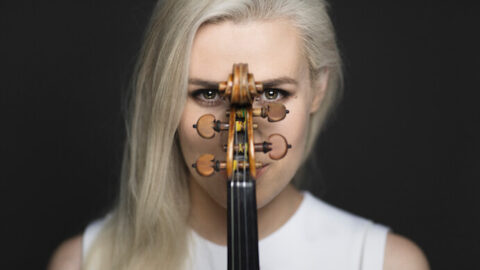Eldbjørg Hemsing recently premiered Fire Ritual: A Musical Ritual in Memory for the Victims of War concerto at Norway’s 2018 Ultima Oslo Contemporary Music Festival, written by Tan Dun for Hemsing’s decade of dedication to his work. Hemsing’s equal comfort in concert and folk music made for surprisingly natural collaboration between the two, and she talked with Lana Norris about her Norwegian roots, experiences in musical diplomacy, and parsing music’s message and purpose.
Take us back to your musical beginnings. What music influenced you in your early years?
My main influence in the early years, if we talk about the composers that I could never get enough of, was Beethoven with his violin concerto–which was surely my absolute favorite. Due to regular travel for certain masterclasses, competitions, and classes, I was also very much influenced by the musical language and tonalities of the two Czech composers Dvorak and Suk. And I could of course not pass the great Tchaikovsky, as well as Bartok.
You have a rich national heritage along with unique international partnerships. How do you stay true to your roots?
In a way, that is not too difficult because tradition is very strong where I come from and has been an integral part of my life. Practically, I try to keep my technique linked to folk music with Hardanger Fiddle fresh both in “my fingers” and my mind. This is truly crucial as the tradition in its core requires the transfer of this knowledge directly from the master to the student, and there aren’t any real documents about it. So generally, I try to do at least a few projects that also require my performance with Hardanger Fiddle.
Folk traditions and natural heritage are truly an integral part of society in my village of Valdres, with both the music, where we even have the luthiers who make the Hardanger Fiddle violins, and national folk costumes.

Your musical partnership with Tan Dun helped Norway and China strengthen their relationship, and in June 2018 you performed at the United Nations. What lessons have you learned promoting diplomacy with music?
I really have both learned and seen through my own eyes how extremely powerful music is in these settings: the universal understanding that music can open a lot of doors and build bridges between people and cultures, a power that can unite, get people a step closer to a dialogue, or in some cases, contribute to the stabilization of certain diplomatic or political frictions. Having the possibility to see beyond political or nationalistic issues, music is what can keep the mind open for different opinions. A little bit like the saying, “If you keep your heart open for music, you also keep your mind open for music.”
In my opinion, one of the most powerful experiences was a project in 2017, when Tan Dun invited me to perform with the China National Traditional Orchestra. This was the very first time a soloist with a western instrument had performed with them, and such a project is an incredible demonstration of the power of music in cultural diplomacy. Many people would say, “This is yet another concert,” but at least through my eyes, this was a very powerful connection between Eastern and Western cultural traditions–connecting two very different music traditions (Tan Dun’s inspiration rooted in Peking Opera traditions and mine in folk music and Hardanger fiddle), cultures, and countries that in recent history did not have the best relationships.

How has working with Tan Dun and his exploration of class divisions in concert music shaped your notion of accessibility?
Yes, Tan Dun is surely one of the great examples of composers that have the greater vision of music universality. What I have learned from Tan Dun is that you should never limit music to a certain type of music. I always strive towards finding a way to translate the message–not necessarily the purpose–but the message and passion to the audiences that you are addressing, or even trying to address. In a way, in order to make music accessible to people, you need to have charismatic individuals that are able to translate and communicate the message of music further.
Tan Dun is an excellent composer and conductor, but he is able to communicate it–not only the music, but messages about the future, philosophy, or spirituality. For example, in his Rhapsody and Fantasia violin concerto that we performed in Oslo, the two main themes in the work were inspired by Peking Opera tradition and hip-hop culture in New York. His works symbolically go beyond the notion of accessibility–actually giving it a democratic representation and recognizing them on the level they need to be recognized.
What is your dream new music or cultural exchange project?
My dream culture exchange project is surely to become an UN /UNESCO Ambassador for culture. I strongly believe that–particularly in today’s society and in the future–culture and music need to play a vital role. There is a need for projects that preserve cultural heritage or contribute towards the awareness of global challenges, including soon to be lost cultures due to global warming and rising sea levels. I truly believe that we artists are the ones that can unite and facilitate the dialogue.
























